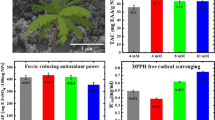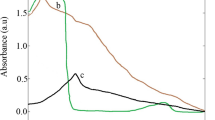Abstract
The objective of this research paper is to investigate a simple, effective, and environmentally-friendly technique for synthesizing Fe2O3 nanoparticles using aqueous-based extract derived from the peels of Citrus sinensis fruit. The primary goal of this method is to produce Fe2O3 nanoparticles with potential antioxidant properties. The biological reducing and capping agents used for this process are the phytochemicals and bioactive compounds present in the aqueous extract of Citrus sinensis fruit peel. Ferrous sulfate was used as the precursor for the synthesis of the Fe2O3 nanoparticles, which were analyzed and characterized using XRD, SEM, EDX, FT-IR, TGA, and zeta potential. According to the findings, the Fe2O3 nanoparticles exhibited a crystalline and spherical structure, and their average size was 22 nm, and a value of – 56.5 mV. TGA spectra determined a weight loss of 36.61% in the nanoparticles in a temperature range of 200–600 °C, because of the thermal decomposition of biomolecules. The strength of the nanoparticles' antioxidant properties was evaluated using a DPPH and ABTS assay and determined to be robust. The maximum scavenging activity of 88–90% was observed at higher concentrations (100 µg/mL) of the nanoparticles. The findings of this research suggest that this eco-friendly synthesis of Fe2O3 nanoparticles from Citrus sinensis fruit peel extract is an efficient method that could potentially have a broad range of biomedical applications due to its antioxidant properties.








Similar content being viewed by others
Data Availability Statement
The data used to support the findings of this study are included within the article.
References
H. Agarwal, S.V. Kumar, and S. Rajeshkumar, Res-Eff. Technol. 3(4), 406 (2017).
J. Huang, L. Lin, D. Sun, H. Chen, D. Yang, and Q. Li, Chem. Soc. Rev. 44(17), 6330 (2015).
M.M. Chikkanna, S.E. Neelagund, K.K. Rajashekarappa, and S.N. Appl, Sci. 1(1), 1 (2019).
P. Rajiv, S. Rajeshwari, and R. Venckatesh, Spectrochim Acta A Mol. Biomol Spectrosc. 112, 384 (2013).
G. Jagathesan and P. Rajiv, Biocatal. Agric. Biotechnol. 13, 90 (2018).
M.A. Alghuthaymi, C. Rajkuberan, T. Santhiya, O. Krejcar, K. Kuča, R. Periakaruppan, and S. Prabukumar, Plants 10(11), 2370 (2021).
B.T. Sone, E. Manikandan, A. Gurib-Fakim, and M. Maaza, Green Chem. Lett. Rev. 9(2), 8590 (2016).
V. Jacob and P. Rajiv, Asian J. Pharm Clin. Res. 12(1), 200 (2019).
G.Ş. Karatoprak, G. Aydin, B. Altinsoy, C. Altinkaynak, I. Koşar M Ocsoy, Enzyme Microb.Technol. 97, 21 (2017).
O.J. Nava, C.A. Soto-Robles, C.M. Gómez-Gutiérrez, A.R. Vilchis-Nestor, A. Castro-Beltrán, A. Olivas, and P.A. Luque, J. Mol. Struct. 1147, 1 (2017).
K. McNamara and S.A. Tofail, Adv. Phys. X2(1), 54 (2017).
S.K. Kale, G.V. Parishwad, and A.S.H.A.S. Patil, ES Food Agrofor. 3, 17 (2021).
A. Saravanan, P.S. Kumar, S. Karishma, D.V.N. Vo, S. Jeevanantham, P.R. Yaashikaa, and C.S. George, Chemosphere 264, 128580 (2021).
T.U.D. Thi, T.T. Nguyen, Y.D. Thi, K.H.T. Thi, B.T. Phan, and K.N. Pham, RSC Adv. 10(40), 23899 (2020).
M. Yusefi, K. Shameli, R.R. Ali, S.W. Pang, and S.Y. Teow, J. Mol. Struct. 1204, 127539 (2020).
N. Beheshtkhoo, M.A.J. Kouhbanani, A. Savardashtaki, A.M. Amani, and S. Taghizadeh, Appl. Phys. A 124(5), 1 (2018).
P. Karpagavinayagam and C. Vedhi, Vacuum 160, 286 (2019).
A. Saravanakumar, M.M. Peng, M. Ganesh, J. Jayaprakash, M. Mohankumar, and H.T. Jang, Artif. Cells Nano. Med Biotechnol. 45(6), 1165 (2017).
M. Jamzad and B.M. Kamari, J. Nanostruct. Chem. 10(3), 193 (2020).
S. Lohrasbi, M.A.J. Kouhbanani, N. Beheshtkhoo, Y. Ghasemi, A.M. Amani, and S. Taghizadeh, Bio Nano Sci. 9(2), 317 (2019).
P. Rajiv, B. Bavadharani, M.N. Kumar, and P. Vanathi, Biocatal. Agric. B iotechnol. 12, 45 (2017).
A. Bouafia and S.E. Laouini, Mater. Lett. 265, 127364 (2020).
J. Wang, S. Zheng, Y. Shao, J. Liu, Z. Xu, and D. Zhu, J. Colloid Interface Sci. 349(1), 293 (2010).
K. Singh, D.S. Chopra, D. Singh, and N. Singh, Arab. J. Chem. 13(12), 9034 (2020).
A.R. Deshmukh, A. Gupta, and B.S. Kim, Biomed. Res. Int. 2019, 1714358 (2019).
A.U. Mirza, A. Kareem, S.A. Nami, M.S. Khan, S. Rehman, S.A. Bhat, A. Mohammad, and N. Nishat, J. Photochem. Photobiol. B Biol. 185, 262 (2018).
W. Muzafar, T. Kanwal, K. Rehman, S. Perveen, T. Jabri, F. Qamar, S. Faizi, and M.R. Shah, J. Mol. Struct. 1269, 13382 (2022).
Acknowledgements
The author is thankful to the Deanship of Scientific Research at University of Bisha for supporting this work through the Fast-Track Research Support Program.
Funding
This research received no external funding.
Author information
Authors and Affiliations
Contributions
Conceptualization validation, supervision and writing—review and editing, data curation, formal analysis by MMA. All authors have read and agreed to the published version of the manuscript.
Corresponding author
Ethics declarations
Conflict of Interest
The authors declare no conflict of interest.
Additional information
Publisher's Note
Springer Nature remains neutral with regard to jurisdictional claims in published maps and institutional affiliations.
Rights and permissions
Springer Nature or its licensor (e.g. a society or other partner) holds exclusive rights to this article under a publishing agreement with the author(s) or other rightsholder(s); author self-archiving of the accepted manuscript version of this article is solely governed by the terms of such publishing agreement and applicable law.
About this article
Cite this article
Abomughaid, M.M. Exploring a Sustainable Approach to Antioxidant Potential of Iron Oxide Nanoparticles Synthesized Using Citrus sinensis Peel Extract. JOM 75, 5388–5393 (2023). https://doi.org/10.1007/s11837-023-05977-2
Received:
Accepted:
Published:
Issue Date:
DOI: https://doi.org/10.1007/s11837-023-05977-2




